
La Earthcache / The Earthcache
Le Massif de l’Estérel est un vaste ensemble montagneux de formation géologique très ancienne, dont les roches contribuent à lui donner des couleurs si caractéristiques.
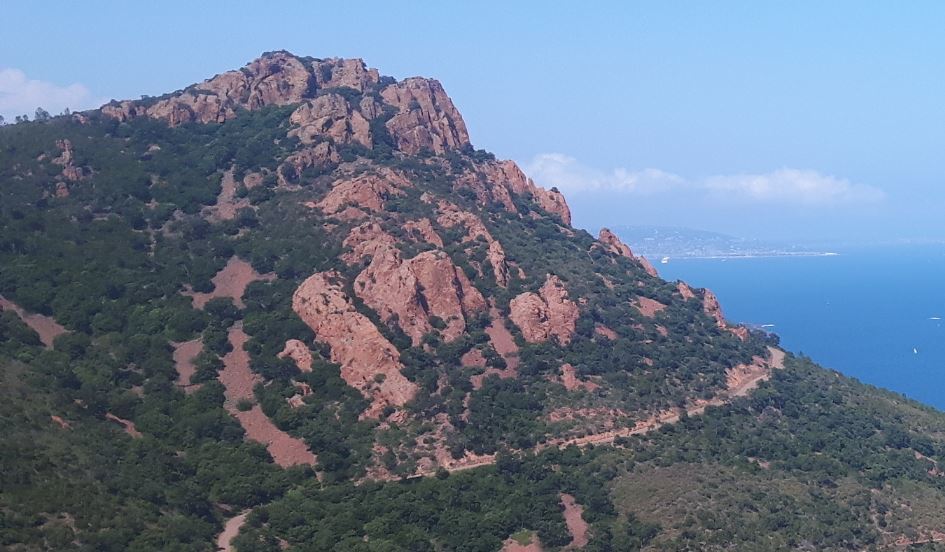
► Contexte géologique local
Une étude plus précise de la carte géologique de la zone du Pic et de la Pointe du Cap Roux permet de caractériser plus particulièrement une formation magmatique, la rhyolite ignimbrique, surnommée couramment le "porphyre" amarante de l’Esterel.
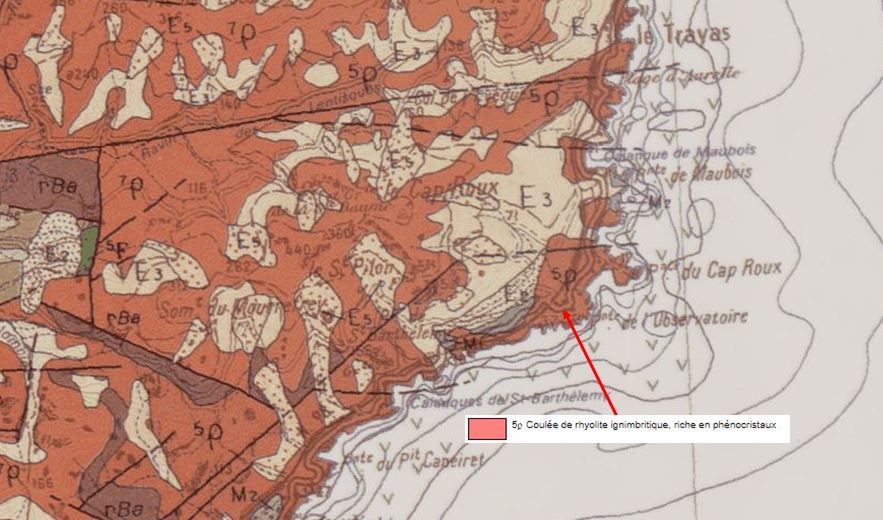
Étudions plus précisément cette roche magmatique aux caractéristiques si particulières.
► Qu'est-ce qu'une roche magmatique ?
Les roches magmatiques (issues de la couche supérieure du manteau terrestre) se différencient en deux grandes familles selon leurs conditions de formation (cristallisation).
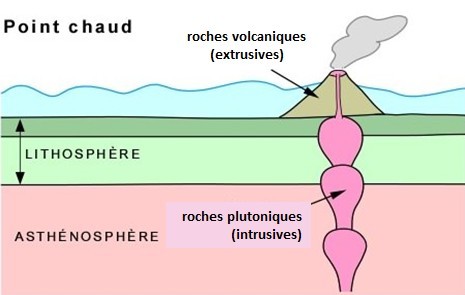
- Les roches volcaniques sont issues d'un magma qui s'introduit dans la croûte terrestre puis se fraie un chemin jusqu'à la surface et donner lieu à des coulées de laves.
Du fait de cette remontée, la cristallisation est très rapide, ce qui produit de très petits cristaux; la roche résultante sera une roche à fins cristaux qu'on ne distingue généralement pas à l’œil nu, même à l'aide d'une loupe. C'est ce qu'on appelle une pâte.
Ces roches volcaniques peuvent être entièrement constituées de pâte (basalte), ou peut contenir des cristaux macroscopiques au milieu de cette pâte (trachy-andésite, domite).
- Les roches plutoniques sont issues d'un magma qui est resté coincé dans la croûte et s'y est cristallisé.
Lorsque le magma cristallise à l'intérieur de la croûte terrestre, l'abaissement de sa température est lent et plus la cristallisation sera lente, plus les cristaux seront gros, généralement bien visibles. Ces roches sont entièrement cristallisées par des cristaux visibles à l’œil nu ; les cristaux peuvent aller de un millimètre (microgranite) à plusieurs centimètres (granite porphyroïde).

► Le "Porphyre" Amarante de l’Esterel
Porphyre est un terme général non scientifique qui désigne plusieurs roches constituées de macro-cristaux noyés dans une pâte.
S'il existe des "porphyres" bleus (estérélites) ou verts, le "porphyre" amarante de l’Esterel est de nature et d'origine différente (amarante est une couleur pourpre plus claire que le bordeaux).
~ Formation
Les roches de l’Esterel date de la fin de l'ère Paléozoïque, il y a 250 millions d'années (Permien).
À cette époque, une intense activité volcanique se produit pendant 30 millions d'années.
Ce volcanisme est lié à une extension de la croûte terrestre, l'éclatement de la Pangée et la formation de la Téthys et se retrouve ailleurs en France (en Corse ou dans le Morvan).
Elle se traduit par la mise en place de formation de basaltes puis de rhyolites rouges, nos fameuses "porphyres" amarantes.
Ces rhyolitiques se sont formées à partir de coulées cristallisées d'ignimbrites, formées de débris de lave projetés puis soudés à chaud, accompagnées de nuées ardentes.
~ Caractéristiques
Les rhyolitiques ignimbriques sont des roches acides (elles sont très riches en silice, plus de 60 %), dont la couleur presque grenat ou couleur vin est dû à une pâte faite d'épidote rose.
Cette rhyolitique doit son surnom à sa texture « porphyrique », car elle présente une importante proportion de phénocristaux de feldspath. On entend par phénocristaux des cristaux notablement plus grands que les autres cristaux qui les entourent (de quelques millimètres à plusieurs centimètres).
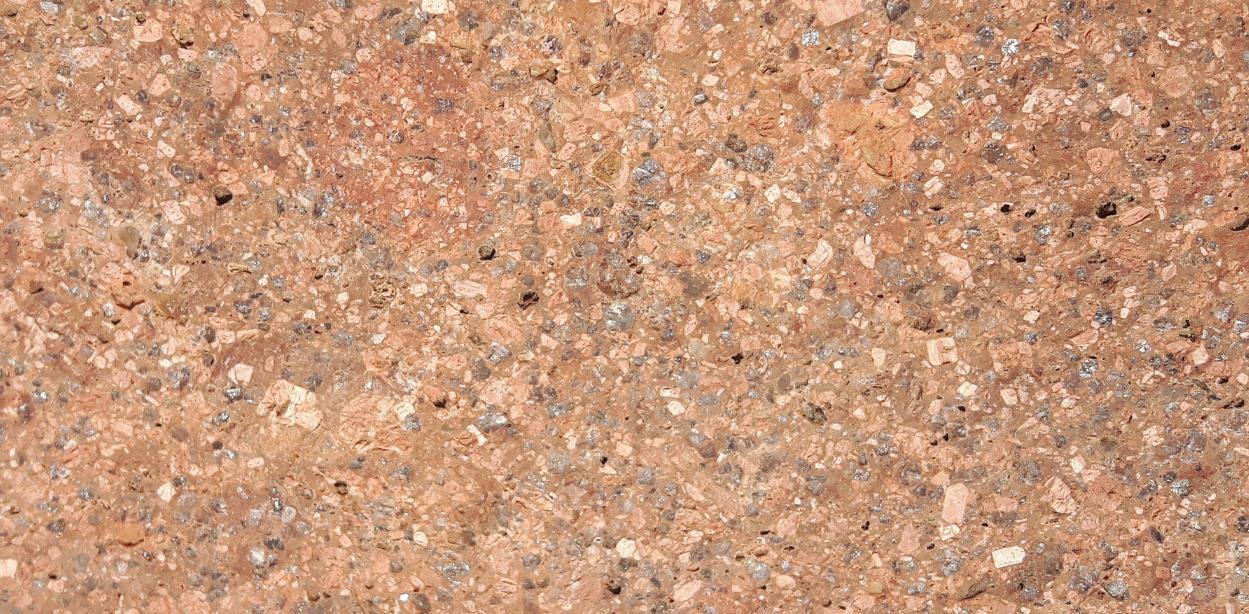
~ Altération
Ramené à l'air libre, le massif de l'Estérel a subit depuis sa formation une forte altération, qui ne permet plus de voir la forme de l'édifice volcanique initial.
Cette altération est toujours en cours, sous l'effet de divers phénomènes physico-chimiques (oxydation par l'eau liquide, éclatement du gel, acidification par la végétation,...).
D'une composition chimique proche du granite (roche magmatique acide), la rhyolite de l'Estérel présente des formes d'altérations assez similaires :
- mise en place de diaclases : fissures et cassures mécaniques issues des mouvements tectoniques se produisant postérieurement à la cristallisation et constituant des zones d'attaques pour l'altération physico-chimique.
- mise en place de cupules : cuvettes circulaires dues à l’hydrolyse à la surface de la roche (altération des minéraux silicatés avec changement d'espèces minérales et réorganisation totale de la structure).
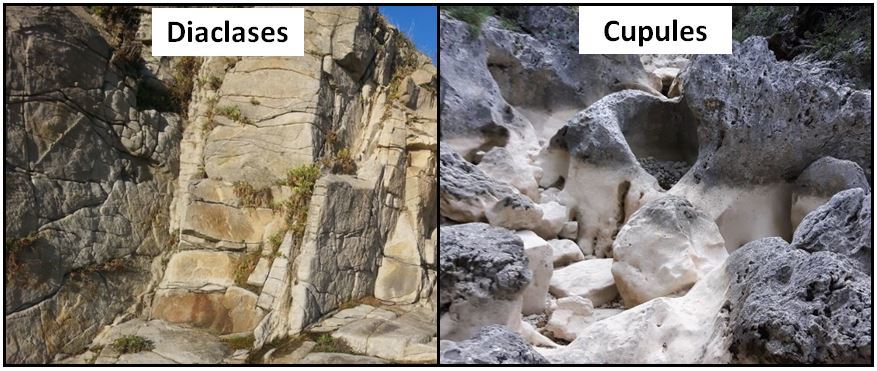
Les processus d'altération sont également à l'origine d'une forte oxydation du fer contenu dans la roche, entrainant une modification de la couleur de celle-ci avec une coloration rouge beaucoup plus foncée (couleur rouge-bordeaux, voire rouille).
The Massif de l'Esterel is a vast mountainous ensemble of very ancient geological formation, whose rocks contribute to give it so characteristic colors.
► Local geological context
A more precise study of the geological map of the Pic and Cap Roux areas makes it possible to characterize more specifically a magmatic formation, the ignichric rhyolite, commonly known as the amaranth porphyry of the Esterel.
Let us study more precisely this magmatic rock with particular characteristics.
► What is magmatic rock?
Magmatic rocks (from the upper layer of the Earth's mantle) are distinguished into two large families according to their formation conditions (crystallization).
- The volcanic rocks come from a magma which is introduced into the earth's crust and then makes its way to the surface and gives rise to lava flows. Because of this rise, the crystallization is very fast, which produces very small crystals; the resulting rock will be a rock with fine crystals that is generally not visible to the naked eye, even with a magnifying glass. This is called a paste.
These volcanic rocks may consist entirely of paste (basalt), or may contain macroscopic crystals in the middle of this paste (trachy-andesite, domite).
- The plutonic rocks come from a magma that has been stuck in the crust and crystallized there.
When the magma crystallizes inside the earth's crust, the temperature drop is slow and the crystallization will be slow, the larger the crystals, usually visible. These rocks are entirely crystallized by crystals visible to the naked eye; the crystals can range from one millimeter (microgranite) to several centimeters (porphyritic granite).
► The "Porphyry" Amaranth of the Esterel
Porphyry is a general unscientific term for several rocks made of macro-crystals embedded in a paste.
If there are "porphyries" blue (estérélites) or green, the "porphyry" amaranth of the Esterel is of nature and of different origin (amaranth is a purple color lighter than the burgundy).
~ Formation
The rocks of Esterel date from the end of the Paleozoic era, 250 million years ago (Permian).
At this time, intense volcanic activity occurs for 30 million years.
This volcanism is linked to an extension of the earth's crust, the bursting of the Pangea and the formation of the Tethys and is found elsewhere in France (in Corsica or in the Morvan).
It results in the establishment of formation of basalts and red rhyolites, our famous "porphyries" amaranth.
These rhyolitics were formed from crystallized flows of ignimbrites, formed of lava debris sprayed and heat welded, accompanied by fiery clouds.
~ Features
The ignichric rhyolitics are acidic rocks (they are very rich in silica, more than 60%), whose almost garnet color or wine color is due to a paste made of pink epidote.
This rhyolite owes its nickname to its "porphyritic" texture, because it has a large proportion of feldspar phenocrysts. By phenocrysts are meant crystals notably larger than the other crystals which surround them (from a few millimeters to several centimeters).
~ Alteration
Brought back to the open air, the Esterel massif has suffered from its formation a strong alteration, which no longer allows to see the shape of the initial volcanic building.
This alteration is still ongoing, under the effect of various physico-chemical phenomena (oxidation by liquid water, bursting of the gel, acidification by vegetation, ...).
With a chemical composition close to granite (acidic magmatic rock), the Estérel rhyolite has quite similar forms of alteration:
- Establishment of diaclases: cracks and mechanical breaks resulting from tectonic movements occurring after crystallization and constituting areas of attack for physico-chemical alteration.
- placement of cups: circular cuvettes due to hydrolysis on the surface of the rock (alteration of silicate minerals with change of mineral species and total reorganization of the structure).
The alteration processes are also at the origin of a strong oxidation of the iron contained in the rock, causing a modification of the color of this one with a much darker red coloring (red-burgundy color, even rust).
► Sources bibliographiques / Bibliographical sources
Les Questions / The Questions
La lecture attentive du descriptif de la cache, ainsi qu'une observation des éléments de terrain et un peu de déduction sont normalement suffisants pour répondre aux questions de cette EarthCache.
A careful reading of the description of the cache, as well as observation of terrain features and some deduction is usually sufficient to answer questions of this EarthCache.
Questions pour valider :"Le Porphyre Amarante de l'Estérel"
Questions to validate: "The Porphyry Amaranth of Esterel"
Point 1 : N 43° 27.364 E 006° 55.338
Vous voici devant un affleurement de roche saine (photo WP1). Approchez vous pour observer la roche de près.
Here you are in front of a healthy rock outcrop (photo WP1). Approach to observe the rock closely.
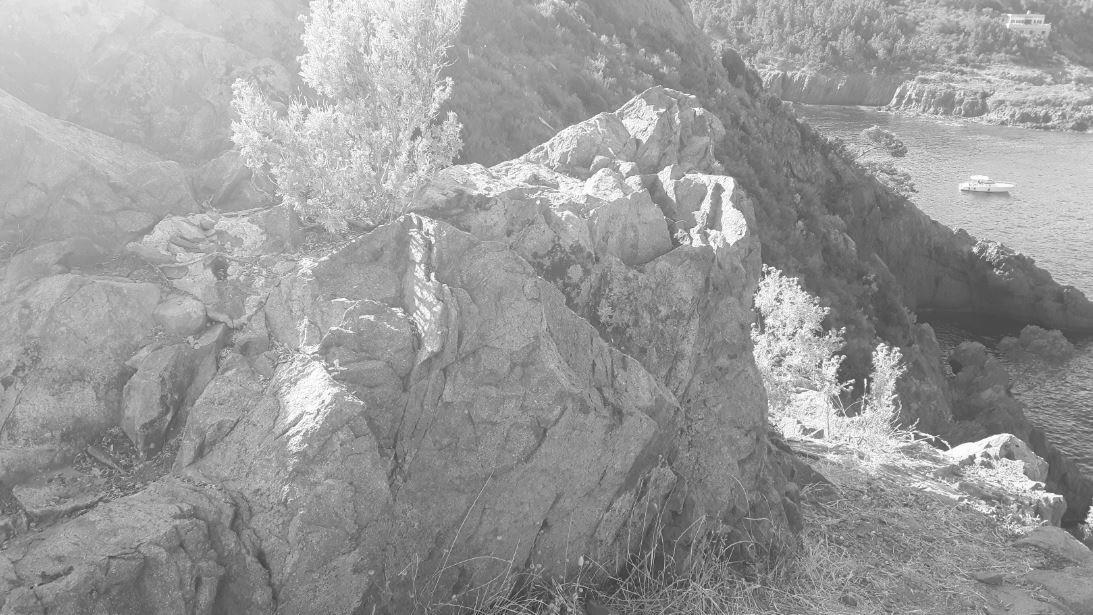
- Question 1 : Pouvez-vous voir les plus petits cristaux de la roche ? Déduisez en la famille de roche magmatique du porphyre rouge.
- Question 1 : Can you see the smaller crystals of the rock? Deduce into the magmatic rock family of red porphyry.
- Question 2 : Quelle est la taille des plus gros cristaux ? Comment pouvez-vous les qualifier et pourquoi ?
- Question 2 : What is the size of the largest crystals? How can you qualify them and why?
- Question 3 : De quelle couleur sont les zones ayant les plus petits cristaux ? Quel minéral (et non quelle molécule) en est à l'origine ?
- Question 3 : What color are the areas with the smallest crystals? Which mineral (and not which molecule) is at the origin?
Point 2 : N 43° 27.361 E 006° 55.321
Vous voici devant deux affleurements de roche altérée, un plutôt côté route, l'autre plutôt côté mer (photo WP2).
Here you are in front of two outcrops of weathered rock, one rather side road, the other rather sea side (photo WP2).
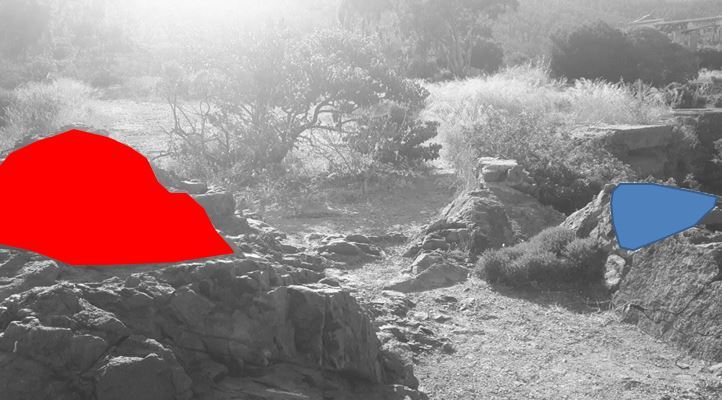
- Question 4 : Observer la zone côté route (zone rouge). Quelle forme d'altération pouvez-vous voir ? Quelle est son origine ?
- Question 4 : Observe the roadside zone (red zone). What form of alteration can you see? What is its origin ?
- Question 5 : Observer la zone côté mer (zone bleue). Quelle forme d'altération pouvez-vous voir ? Quelle est son origine ?
- Question 5 : Observe the sea side area (blue area). What form of alteration can you see? What is its origin ?
Vous pouvez vous loguer sans attendre notre confirmation,
mais vous devez nous envoyer les réponses en même temps soit par mail via notre profil (
fafahakkai), soit via la messagerie geocaching.com (Message Center).
S'il y a des problèmes avec vos réponses nous vous en ferons part.
Les logs enregistrés sans réponses seront supprimés.Une photo de vous ou de votre GPS le pic Roux ou la mer en arrière plan est la bienvenue, mais n'est pas obligatoire.
You can log this cache without waiting for our confirmation, but you must send us the answers at the same time, by e-mail via our profile (fafahakkai) or by the system of Message Center of geocaching.com.
If there is a problem with your answers we will notify you. The logs recorded without answers will be deleted.
A photo of you or your GPS Peak Roux or the sea in the background is welcome, but not mandatory.
Rappel concernant les « Earthcaches »: Il n'y a pas de conteneur à rechercher ni de logbook à renseigner. Il suffit de se rendre sur les lieux, de répondre aux questions ci-dessus et de nous renvoyer les réponses.
Reminder concerning "Earthcaches": there is neither a container to look for nor a logbook to sign. One need only go to the location, answer to the differents questions and send us the answers.